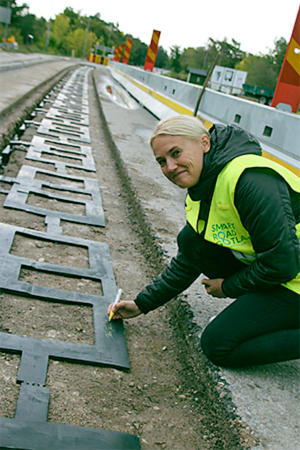The road to the future

Sweden is a pioneer of electric road systems and aims to reduce greenhouse gas emissions from domestic road transport by 70 percent from 2010 to 2030. However, to achieve just a 20 percent cut by 2020, the country needs to lower emissions by one million tons a year between now and 2030.
By 2035, the government wants to find 3,000 kilometers of roads with heavy traffic that can be adapted for electrification. The Swedish Transport Administration, Trafikverket, has been identifying suitable roads and so far, four solutions have been tested.
At the first site, an overhead power line charged trucks via pantographs mounted on their roofs. The four-year test period — along two kilometers of the E16 highway close to Sandviken in central Sweden — ended in 2020.
The second option is the eRoad Arlanda project, a two-kilometer section of the road between Stockholm’s Arlanda Airport and the Rosersberg logistics center. Vehicles use a movable arm to pick up electricity from an electric rail embedded in the road. The test began in 2018.

A third alternative is a conductive connection between the electric road and the vehicle through a pick-up under the vehicle. The pick-up connects to the road by sliding along electric rails laid on top of the road, efficiently transmitting power and charging the vehicle’s batteries. This solution is being trialed between 2020 and 2022 in the Evolution Road project in Lund, southern Sweden, using a city bus as the main test vehicle.
The e-mobility market is fast paced with new technologies and companies constantly emerging. Original equipment manufacturers and system suppliers face distinctive challenges and ever-changing requirements because customers do not have clearly defined standards or established solutions. The innovation rate is intense, with pressure to quickly bring the right products to market.
Fourthly, the Smartroad Gotland focuses on a 1.6-kilometer-long electric road between the airport and town center of Visby on the Baltic Sea Island of Gotland. It is an inductive system where receivers pick up electricity under the vehicle’s chassis from a copper cord sunk into the road. The three-year test ends in 2022.
“It takes a multitude of solutions to make it possible for all kinds of traffic to switch to a fossil-free system,” says Jan Pettersson, head of Trafikverket’s program for electrification of heavy transport.
“Electric roads are a solution with big potential that also utilizes existing road infrastructure. It may also need to use other technologies than those in these demonstrations.”
In its latest report on electric road development, Trafikverket says that the electric road concept will be most suitable for long-distance transport on the roads with most traffic; the priorities being between the cities of Stockholm, Gothenburg and Malmö.
The incentive to invest in vehicles for electric roads will depend on the share of goods transported on these roads, and Trafikverket calculates that the volume should be 40 percent or more to make this solution profitable.
Pettersson is hopeful. “Based on the demonstrations and other considerations, we’ve identified at least 2,400 kilometers of roads that are suitable for electrification,” he says.
E-mobility is booming. To keep the momentum going, customers need reliable and competent component suppliers who can react quickly to meet their needs: from design, product development and prototyping through to serial production.

Trelleborg is ready. Its dedicated customer focus and combination of innovation, technology, and an efficient R&D organization leads to a reduction in the time needed to develop products and manufacture the first functional prototypes.
To these electric road projects, Trelleborg supplied tailor-made sealing solutions, including a special EPDM material with very low conductivity.
“We’ve developed customized rubber sealing for the electric rails,” says Anna Scheuren, Business Development Manager for seals and profiles within Trelleborg Industrial Solutions.
“The seals have to provide a reliable sealing function against water ingress into the rail system and maintain electric conduction to the pick-up connection area.
“It’s a very demanding application not only due to the wear caused by the pickup device under the test vehicles, but also from the usual non-electric traffic on the road. The sealing has to withstand very harsh weather conditions, with road temperatures ranging from minus 40 degrees Celsius during the coldest part of the winter to more than 60 degrees Celsius on the hottest summer days.”
In addition to electric road projects, Trelleborg is constantly developing leading solutions for all parts of the e-mobility industry.
“We’re proud to be a key player in this booming and important market and will continue to push for the next innovation that will allow electric vehicles to go farther and faster more effectively,” says Scheuren.
Ethylene Diene Propylene Monomer (EPDM) sheeting is one of the most versatile types of rubber sheeting and best suited for outdoor applications. It is highly resistant to wear and tear, even in the most aggressive external conditions such as steam, UV rays, ozone, saltpeter or extreme weather. EPDM sheeting also maintains its properties under a wide range of temperatures, making it ideal for general industry and construction, automotive, marine and outdoor applications. The EPDM sheeting used in the electric road projects was tailor-made for the application.
For more information, please go to:
This is an article has been reproduced from Trelleborg's T-Time magazine. To download the latest edition, go to: www.trelleborg.com/t-time